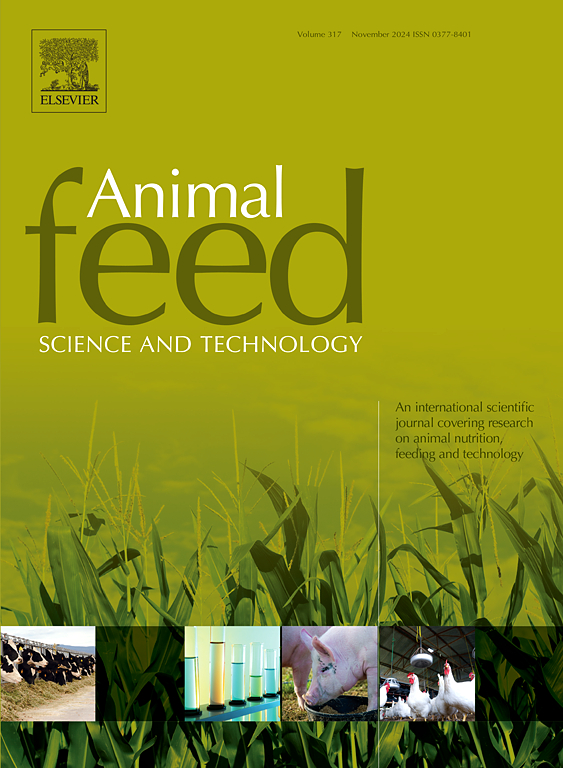Growth performance, digestive enzyme activities, intestinal histology and glucose metabolism in abalone Haliotis discus hannai affected by different starches in practical diets
IF 2.5
2区 农林科学
Q1 AGRICULTURE, DAIRY & ANIMAL SCIENCE
引用次数: 0
Abstract
The present study was conducted to explore the effects of different sources of dietary starch on the growth performance, gut health and glucose metabolism of abalone Haliotis discus hannai. Four experimental diets formulated with wheat starch, sweet potato starch, pea starch and corn starch, respectively, were fed to abalones (initial weight 4.56 ± 0.05 g) for 90 days. The results showed that the weight gain rate (WGR) of abalone in the pea starch group was the significantly highest (192.51 %) one, while the WGR in the wheat starch group was the lowest (174.36 %) one among all the four groups (P < 0.05). The intestinal α-amylase activity was higher in the corn starch and pea starch groups. The intestinal lipase activity was highest in the corn starch group, followed by the wheat starch group, and lowest in the sweet potato starch group. In terms of intestinal morphology, the intestinal villus width, height and perimeter ratio had the highest values in the pea starch group. In terms of glucose metabolism, both gluconeogenesis and glycolysis were at lower levels in the pea starch group, while glycogen synthesis was at a higher level. In conclusion, among the wheat starch, sweet potato starch, pea starch and corn starch, considering the growth, digestion and glucose metabolism, pea starch is recommended as a better dietary starch source for abalone.
实际饲料中不同淀粉对鲍鱼生长性能、消化酶活性、肠道组织学和糖代谢的影响
本试验旨在探讨饲粮中不同来源淀粉对银盘鲍鱼生长性能、肠道健康和葡萄糖代谢的影响。分别以小麦淀粉、甘薯淀粉、豌豆淀粉和玉米淀粉配制4种试验饲粮,饲喂初重4.56 ± 0.05 g的鲍鱼90 d。结果表明,豌豆淀粉组鲍鱼的增重率(WGR)显著最高(192.51 %),小麦淀粉组最低(174.36 %)(P <; 0.05)。玉米淀粉组和豌豆淀粉组肠道α-淀粉酶活性较高。肠道脂肪酶活性以玉米淀粉组最高,小麦淀粉组次之,甘薯淀粉组最低。在肠道形态方面,豌豆淀粉组的肠绒毛宽度、高度和周长比值最高。在糖代谢方面,豌豆淀粉组糖异生和糖酵解水平较低,糖原合成水平较高。综上所述,在小麦淀粉、甘薯淀粉、豌豆淀粉和玉米淀粉中,考虑到鲍鱼的生长、消化和葡萄糖代谢,推荐豌豆淀粉作为鲍鱼较好的饲粮淀粉源。
本文章由计算机程序翻译,如有差异,请以英文原文为准。
求助全文
约1分钟内获得全文
求助全文
来源期刊

Animal Feed Science and Technology
农林科学-奶制品与动物科学
CiteScore
6.00
自引率
6.20%
发文量
266
审稿时长
3 months
期刊介绍:
Animal Feed Science and Technology is a unique journal publishing scientific papers of international interest focusing on animal feeds and their feeding.
Papers describing research on feed for ruminants and non-ruminants, including poultry, horses, companion animals and aquatic animals, are welcome.
The journal covers the following areas:
Nutritive value of feeds (e.g., assessment, improvement)
Methods of conserving and processing feeds that affect their nutritional value
Agronomic and climatic factors influencing the nutritive value of feeds
Utilization of feeds and the improvement of such
Metabolic, production, reproduction and health responses, as well as potential environmental impacts, of diet inputs and feed technologies (e.g., feeds, feed additives, feed components, mycotoxins)
Mathematical models relating directly to animal-feed interactions
Analytical and experimental methods for feed evaluation
Environmental impacts of feed technologies in animal production.
 求助内容:
求助内容: 应助结果提醒方式:
应助结果提醒方式:


